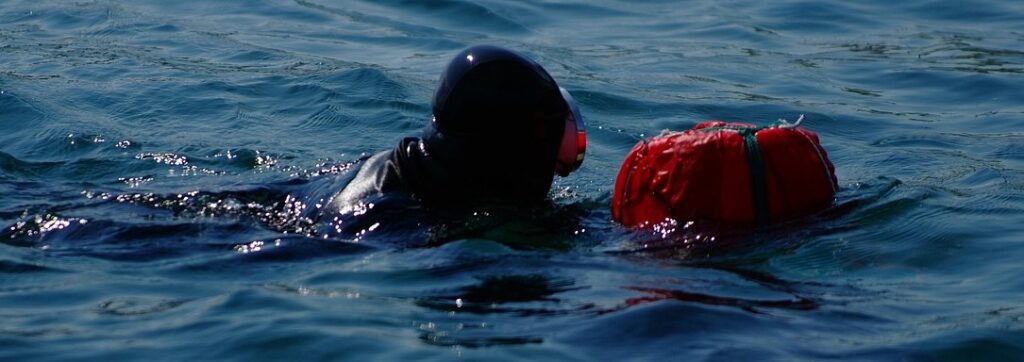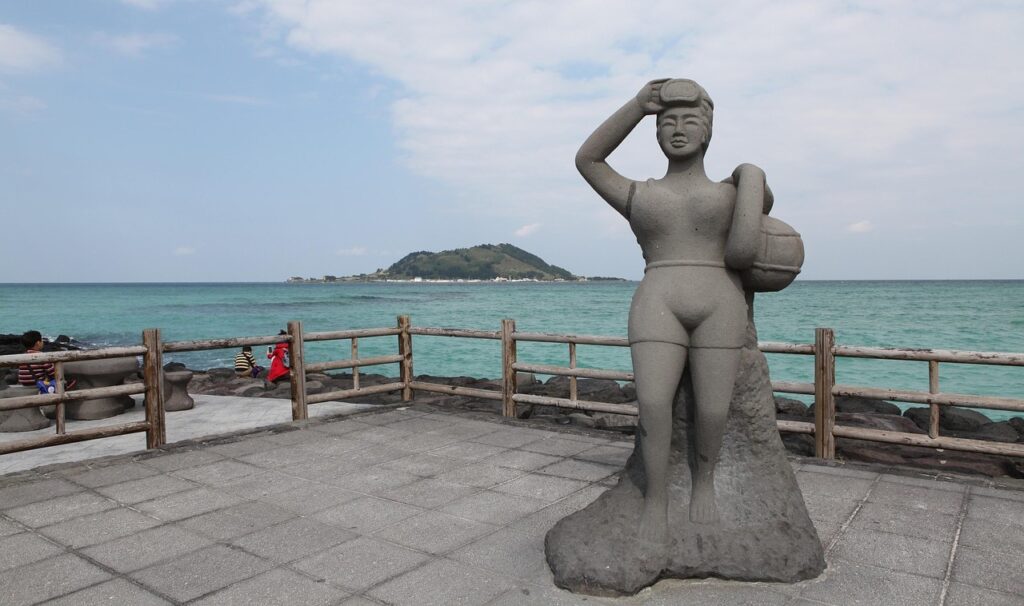Netflix’s recent drama, When Life Gives You Tangerines, became a huge hit both in Korea and abroad. Right from the start, the show captivated audiences with its focus on haenyeo, or female divers, from Jeju Island. It beautifully depicted the joys and sorrows of their lives, highlighting a significant part of the island’s culture.
Similarly, the JTBC documentary Deep Dive Korea: Song Ji-hyo’s Haenyeo Adventure, co-produced with BBC Studios, has been airing. The documentary was created to share the haenyeo culture, sensitively portraying the strong spirit and way of life of Jeju’s haenyeo. Viewers were deeply moved by actress Song Ji-hyo’s journey to understand the challenging lives of these women who have made a living from the vast sea with only a tewak, a flotation device.
The Origin of the Term ‘Haenyeo’
‘Haenyeo’ (海女), which means “sea women,” refers to women who dive in shallow waters to gather marine products. In the southern coastal regions of Korea, they were called murekkun, while on Jeju Island, they were known as jamnyeo (잠녀, 潛女) or jamsu (잠수, 潛嫂). The term ‘haenyeo’ emerged during the Japanese colonial period and became more common after the 1980s, though it is still not widely used on Jeju Island. In the 1960s, they were also called tongjaengi in Busan’s Yeongdo district, a term believed to have originated from their use of wooden barrels instead of a tewak. This use of wooden barrels can also be seen among Japanese ama (海女, 海士) divers and is thought to be an influence from Japanese fishing villages that existed in Yeongdo during the colonial era.

Unique Female Divers Around the World
While diving for marine products is a common practice globally, the act of diving for a living without special equipment is a tradition found almost exclusively in Korea and Japan. Similar activities exist on a smaller scale in Southeast Asia and Russia. Jeju Island, in particular, has gained global attention for having the highest concentration of female divers in the world. Although haenyeo are scattered across Korea’s coastal areas and islands, the majority are on Jeju.
Historically, Jeju haenyeo didn’t just work in their home areas; they would travel to other regions and even foreign countries for several months at a time. After Korea’s ports opened in 1876, Japanese fishermen’s expansion led to the depletion of Jeju’s fishing grounds, threatening the haenyeo’s livelihoods. In response, they began to migrate north along the East Coast, traveling through Gyeongsangbuk-do and Gangwon-do up to Cheongjin. They also expanded their activities to the South and West Coasts, Ulleungdo, and Heuksando, and even to various parts of Japan, Vladivostok, Dalian in the Liaodong Peninsula, and Qingdao in Shandong Province. They would typically leave in the spring and return in the fall. Diving in regions outside of Jeju was fundamentally seasonal migrant work passed down by Jeju’s haenyeo.
‘Haenyeo’ in Historical Texts
The haenyeo profession is one of the many that emerged naturally over time. Historical records mention their existence in various ancient texts, including Samguk Sagi (History of the Three Kingdoms). In 1105, during the reign of King Sukjong of Goryeo, there’s a record prohibiting “nude diving by haenyeo.” Later, during the Joseon era under King Injo, the governor of Jeju reportedly forbade “men and women from working together in the sea.” This suggests that haenam, or male divers, also existed back then.
Male divers were known as pojak-in (鮑作人) or pojak-gan (鮑作干). From the Goryeo dynasty, Jeju was required to present abalone and seaweed as tribute to the royal court. Seaweed was primarily gathered by haenyeo, while abalone was the responsibility of the pojak-in. As the quota for abalone tribute increased, many men fled to the mainland. Consequently, a “Prohibition on Leaving the Island” was enacted to prevent Jeju residents from escaping, which lasted for 200 years starting in 1629. Jeju women were even forbidden from marrying men from the mainland, and the construction of fishing boats was also banned—all to ensure the tribute was properly paid. The ban was lifted around 1850, allowing Jeju residents to travel to the mainland. It was then that Jeju haenyeo began their seasonal migrations to places like Busan and Ulsan to earn a living.
Haenyeo Equipment
Haenyeo harvest various marine products like sea snails, abalones, octopus, sea cucumbers, sea squirts, seaweed, and gulfweed, and occasionally catch fish with a spear. Their essential tools include a tewak, a flotation device they hold to their chests while swimming, and a mang-siri, a net bag attached to the tewak for storing their catch. When they dive, the tewak and mang-siri float on the water’s surface. The gear they take with them underwater includes a bitchang, a long metal tool for prying off abalones; a jeonggehomi, a sickle for cutting seaweed; a galgori, a metal hook-like rake for digging out shellfish; and a sosar, a spear for catching fish. Haenyeo wear a mul-ot, or diving suit, and nun, or goggles. The diving suits have evolved from cotton to rubber. The goggles, originally a small, binocular-style pair called jokse-nun, were replaced by larger ones known as wang-nun starting in the 1950s.
Haenyeo Culture
Becoming a haenyeo wasn’t about a person being special from birth. It was about becoming strong and skilled through repeated diving and training. Historically, young girls in Jeju’s coastal villages learned to dive in shallow waters called aegi-badang. They learned by observing experienced haenyeo, listening to their stories, and mastering the skills through their own repeated practice. It was common for daughters of haenyeo and daughters-in-law of haenyeo mothers-in-law to also become haenyeo. Girls born on Jeju learned to swim and practice mujamakjil—a diving technique of repeatedly submerging and surfacing—starting at age seven or eight. By 12 or 13, they would practice diving deeper, and by 15 or 16, they would become full-fledged haenyeo. Their diving activities were most active around age 40, and they often continued diving until their 60s, or even into their 70s.
Based on their skill and experience, Jeju’s haenyeo are divided into three groups: sang-gun (上軍, senior divers), jung-gun (中軍, intermediate divers), and ha-gun (下軍, junior divers). Sang-gun haenyeo, with their vast experience and knowledge of reefs and marine life, lead the community by sharing their wisdom. From them, junior divers learn not only the necessary diving skills but also knowledge of haenyeo culture and a sense of responsibility to their community.

A Global Intangible Cultural Heritage
The haenyeo’s diving method is a traditional Korean fishing technique that is both primal and unique. Haenyeo are living testaments to Korea’s traditional maritime and female fishing cultures. Their work and culture offer insights into coexistence between humans and nature, as well as the sustainable use and distribution of communal resources. The haenyeo community has a distinct culture built on folk knowledge of the ecosystem, which they’ve gained through years of diving, as well as on camaraderie, collaboration, and unique rituals and beliefs.
Recognizing the outstanding historical, artistic, and unique value of this intangible heritage, “Haenyeo” was designated as National Intangible Cultural Heritage No. 132 in May 2017 to preserve and pass on the tradition. The value of haenyeo culture is recognized not only in Korea but also globally. In 2016, “Culture of Jeju Haenyeo (Women Divers)” became the 19th Korean heritage to be inscribed on UNESCO’s list of Intangible Cultural Heritage of Humanity. The inscribed heritage includes muljil (the diving culture of harvesting marine life without an oxygen supply), jamsu-gut (shamanistic rituals to pray for the safety of the haenyeo and a bountiful catch), haenyeo norae (haenyeo songs sung on the boats), and the transmission of women’s roles through mothers and generations. Haenyeo culture received high praise for symbolizing a unique regional identity, promoting sustainable environmental practices, and transmitting its knowledge and skills through the community.
Globalizing Haenyeo Culture
The number of haenyeo is declining due to an aging population, global warming, depletion of marine resources, and harsh working conditions. Therefore, it is especially meaningful that the culture of Jeju haenyeo has been listed as an Intangible Cultural Heritage of Humanity and is gaining international recognition. It’s particularly welcome that it’s becoming more known globally through productions like the Netflix drama When Life Gives You Tangerines and the BBC-JTBC documentary Deep Dive Korea: Song Ji-hyo’s Haenyeo Adventure. We hope that Korea’s haenyeo and their culture will continue to be shared with the world, becoming not just a national heritage but a global one.